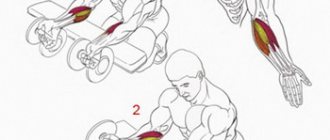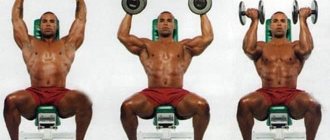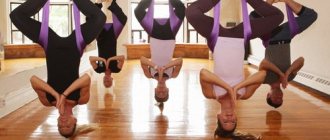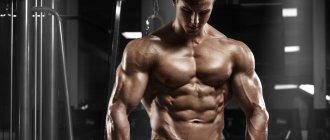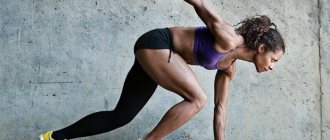What muscles does the Arnold press work?
The main task in the Arnold press is to develop the muscles of the shoulder girdle. Namely:
- Deltoid muscles. It is this press that puts a lot of stress on the front head
(initial phase).
Then it shifts to the middle head
(middle phase of execution).
And in the end, although small, the load goes to the back head
(shoulder stabilization in the upper phase). - Rotator cuff muscles. This is a group of muscles that are responsible for rotating and stabilizing the humerus. It includes: supraspinatus
,
infraspinatus
,
subscapularis
and
teres minor.
In addition to the main muscles, there are secondary ones. Who also take part in the movement. This:
- Triceps . Extends the arm at the top of the exercise.
- Coracobrachialis muscle. Responsible for flexing and adducting the shoulder to the body. That is, it actively works when returning to its original position. It also holds the humerus in the joint.
When performing the Arnold press standing, not sitting. Additionally, the muscles responsible for stabilizing the body will work.
- Press
- Back extensors
- Gluteal
- Thigh muscles (anterior and posterior groups)
- Calf muscles
This entire muscle army will serve us when performing this exercise.
What muscles work?
The exercise is basic for the deltoid muscles. All deltoids are pumped, but this is especially true for the middle and front bundles. It is the middle bundles of deltas that provide good relief. Due to their work, the shoulders become more voluminous. The posterior heads of the shoulders are less involved.
At the start of the press, the front heads are activated. Next, after turning the hands, the lateral and rear deltoid muscles are involved in the work, as well as those due to which rotation of the shoulders occurs:
- coracobrachial;
- supraspinatus;
- infraspinatus
When extending your arms, significant tension goes to the triceps. They get a stronger load than with regular bench presses.
Other muscles are also used to a lesser extent:
- lats;
- round;
- small dorsal.
If the exercise is done in a standing position, then there is an additional load on the stabilizer muscles:
- hamstring biceps;
- abdominal muscles;
- spinal extensors.
A distinctive characteristic of the bench press is that during the exercise the tension from the deltas does not go away, but remains constant.
Advantages and disadvantages
Advantages
- In this press, the front head of the deltoid muscles is constantly under tension. This contributes to its better development.
- Helps give the shoulder muscles a more expressive shape.
- This press helps strengthen the rotator cuff muscles. Due to rotation in the shoulder joint and working with light weight.
And that, unfortunately, is all. And then the question immediately arises, how is this possible?? After all, this exercise was performed by Arnold Schwarzenegger himself, it cannot have so few benefits. In fairness, it is worth noting that his shoulders have never been his strong point. There was a particular lack of development in the middle beams. From this we can conclude that there were some flaws in the training of the eight-time Mr. Olympia. Of course I don't presume to condemn him. Because he is truly the greatest athlete. And during certain training periods, the Arnold press may even be appropriate. For example, when preparing for competitions or during drying to give them relief. But unfortunately, it is not suitable for everyday training.
Flaws
- With poor technique and incorrectly selected dumbbell weights, you can easily injure the rotator cuff muscles. They are especially vulnerable at the moment of abduction and rotation of dumbbells from the initial position to the middle one.
- A very large load falls on the front head. And since she already works in a large number of basic exercises. Starting from: DUMBELL PRESS and ending with Push-ups. There is no point in doing additional exercises for it. On the contrary, this may overwork this head. And cause injury.
- By performing the Arnold press, we will not be able to build muscle mass. Since this exercise is more aimed at giving relief.
- The exercise is not suitable for beginner athletes. Since there is a high risk of injury and very little return in muscle growth.
That is, to summarize the above. This can be concluded. That Arnold's bench press does not live up to the hopes that most athletes place on it. And most likely it is still popular, since it is named after the idol of most builders. But it is still worth considering the fact that during certain training periods this exercise can be effective. And to slightly reduce the risk of injury, you should leave room for it at the end of the workout and take light weights.
Arnold press technique
Most often, the Arnold press is performed while sitting on a bench. This gives an additional point of support. That is, we rest our feet on the floor and sit with our pelvis on the bench. Athletes who want to unload their backs can additionally rest against the back of a bench set at an angle of 80-90°. The exercise itself consists of 3 stages. Pulling the elbows to the side, turning the dumbbells and the bench press itself.
Initial position:
- Go to the bench press. If you need a backrest, then raise it to the desired height.
- Take dumbbells of the desired weight in your hands and sit down. Press your shoulder blades firmly against your back (when working without it, keep your back straight). Bend your lower back slightly.
- Spread your legs wide and place them on the floor.
- Curl your arms with the dumbbells as if you were doing a BICEPS CURL. Palms face back.
- Raise your elbows slightly upward until you feel tension in the front head of the deltoids.
Performance:
- As you exhale, we begin to move our elbows in different directions from the bottom point. And at the same time, turn the dumbbells counterclockwise. Until the palms point forward. And without pausing, press the dumbbells up in an arc. That is, at the top we bring them together a little.
- While inhaling, we return to the starting position. Doing the same thing, only in reverse order. We lower our hands down, bring our elbows together while simultaneously rotating the dumbbells clockwise.
At first, the exercise will seem difficult, and you will sometimes get confused. But after just a few approaches, your neuromuscular connection will strengthen and the movement will become familiar. The main thing is not to rush. The main goal of the exercise is to feel the work of each head of the deltas. And perform the movement by reducing them.
Arnold Press
Performing a standing Arnold press will make the exercise more multifunctional. By engaging the muscles of the back, legs and abdomen. Which will provide stability to your body and will receive a static load. But unlike the sitting option, you will have to focus not only on the movement itself, but also on stabilizing the body. And if you take into account the fact that the Arnold press already requires good coordination. We can conclude: only professional athletes can perform this option correctly. The main thing when performing while standing is not to turn the exercise into throwing dumbbells by pushing with your legs. This will turn the exercise into a kind of shvung. And the risk of shoulder injury will increase.
Content
- 1 What muscles are trained during the Arnold press?
- 2 How to perform the Arnold press correctly
- 3 Common mistakes when performing the Arnold press
- 4 Additional materials
Arnold press: muscles
Video: standing Arnold press
Video: Arnold Seated Press
Absolutely right: this bench press is named after that legendary bodybuilder - Arnold Schwarzenegger. However, it is not a fact that he invented it. This is most likely not the case. However, it seems that it was he who “lit up” in front of journalists’ cameras while performing such a bench press – and that’s where the name stuck.
The Arnold press is rightfully considered one of the best exercises for targeting the deltoid muscles of the shoulders . No bodybuilder can call himself a bodybuilder if he does not have pronounced bulges in this area of the body. It is they who give the figure a characteristic silhouette, along with the developed latissimus dorsum. Therefore, the Arnold press certainly belongs to the category of exercises that every athlete, without exception, should have in his arsenal.
The Arnold Press, unlike many other bodybuilding exercises, has no variations. That is, it is performed exclusively with dumbbells. Although it is permissible to perform it both from a standing and sitting position.
Arnold One Arm Press
This is a very rare option. It is mainly used for restoration purposes. Also, working with each hand in turn, we will load the oblique abdominal muscles. Which will prevent the body from tilting towards the working arm. To be honest, I don’t see any particular advantages in this option. Since the exercise will take much longer to complete. And these costs are not so justified. But if you have a desire, you can try it in action.
Recommendations for implementation
- Movements should be under your strict control. Don't let your shoulders drop down due to inertia.
- Don't get too hung up on rotating the dumbbells. When you begin to move your elbows to the side from the starting position, your forearm will automatically begin to rotate in the desired direction.
- In the middle phase of the exercise, make sure that your elbows are in the same plane as your body (not moving forward or backward). This will allow maximum use of the middle head.
- When performing a standing press, do not help yourself press the weight by swinging. This may cause spinal injury.
- At the top point, do not straighten your arms completely. This will take the load off the deltoids and can overload the elbow joint.
Common mistakes
The overall score for the load on the target muscles is 22, this is a fairly high indicator, and it is not surprising that mistakes are often made when performing it. The effectiveness of the technique performed will directly depend on compliance with the rules. If the exercise is performed incorrectly, the athlete may get injured.
Quite often, athletes make the following mistakes when using the Arnold technique:
- try to perform techniques with a large working weight;
- when performing a bench press, the body tilts backward;
- improper dumbbell press;
- rotation of the hands when starting to lift the dumbbells.
Only correct adherence to the technique, regardless of body position at the time of performing the exercise, will help avoid injury and allow you to achieve the desired result.
Basic mistakes when performing the exercise
Too much dumbbell weight
As trivial as it may seem, it is the use of inappropriate weight that causes violation of technique and serious injuries. I don’t know why, most athletes forget about this. As for this exercise, the working weight should be much less than in classic bench presses. By about 30%. This is of course not an exact number. But it's perfect as a guide.
Strong arch in the lower back
This error stems from the first one. Athletes take large dumbbells in their hands, but they cannot squeeze them by contracting the deltoids. And in order to cope with the weight, they begin to sag in the lower back. This makes it possible to involve the pectoral muscles in the work. Which of course greatly simplifies the exercise. As a result, its effectiveness suffers and the deltoids do not receive the necessary load. But this is not the worst thing! This technique greatly overloads the spine, putting it in a very dangerous position. Consequently, over time, we can become seriously injured.
Low elbows at the starting point
When performing the Arnold press, the main task is to keep the deltoids under tension at all times. To do this, we bring our elbows forward in front of the body to load the front head. If you lower them lower, almost to the same level as the torso. The entire load will shift to the biceps. In this case, the dumbbells will have to be lifted from a dead center. And if at the beginning of the approach we will be able to do this with ease. Then towards the end, you will have to resort to cheating. And in order to squeeze the weight, we involuntarily begin to sway. In this case, the dumbbells will simply be thrown up in a big way. This technique can easily injure the muscles of the shoulder and rotator cuff.
Tips for maximum efficiency
- Before starting your workout, be sure to do exercises to warm up your entire body. Pay special attention to the shoulder joints and neck. To warm up, you can use the usual exercises that you remember from physical education lessons.
- If you experience pain or discomfort during exercise. You should stop the exercise immediately.
- In order to increase the load on the middle head. In the middle phase (elbows moving to the sides), you need to tilt your hands slightly inward. This will shift the center of gravity slightly. This technique was used by the very first Mr. Olympia Larry Scott.
- Before performing working approaches, do 1-2 warm-up approaches with light weight.
- It is best to perform the Arnold press at the end of your workout. Using light weight and performing the exercise in an average number of repetitions. Approximately 4 sets of 12-15 reps.
- At the end of your workout, be sure to do a small set of muscle stretching exercises.
Unfortunately, the Arnold press is not effective. Yes, with its help you can slightly improve the relief of the deltoid muscles. But due to the complexity of the movement itself, it is better to choose other isolated exercises for this role. So, whether to do it or not, the decision is up to you. The main thing is not to forget about the technical points that will help you avoid injuries. If you have something to say about this bench press, I will be glad to read it in the comments.
Good luck to everyone in your training!
Useful tips
To get the maximum benefit from the exercise, you should consider the following recommendations:
- Do not use maximum weights, but use moderate ones. The weight of the dumbbells should be such that you can do 8-10 repetitions with sufficient load, but without overexertion. This will allow you to perform the exercise as efficiently as possible, specifically with those muscle groups that need stimulation.
- Be sure to press your back against the back of the bench when doing the seated press. This will relieve your spine. Direct your gaze straight ahead.
- Lift the dumbbells as slowly as possible. Do not straighten your elbows completely. Also lower the dumbbells down at a slow pace.
- Do not drop the dumbbells after reaching the top point, otherwise the load from the deltoids will shift to the spine, which is ineffective and unsafe.
- Turn your palms when the dumbbells are at eye level, but not earlier. This will keep the tension on the muscles and avoid injury.
- At the top point of the lift, do not knock the dumbbells against each other and bring them too close to you.
- Raise the dumbbells in a straight vertical line. Try not to separate them from each other at the top. The forearms are also in a vertical position.
The Arnold press is a formative exercise for relief, so it should be performed on warmed muscles at the end of the session.
